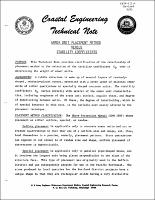Please use this identifier to cite or link to this item:
https://hdl.handle.net/11681/2164Full metadata record
| DC Field | Value | Language |
|---|---|---|
| dc.contributor.author | Coastal Engineering Research Center (U.S.) | - |
| dc.date.accessioned | 2016-03-11T18:45:23Z | - |
| dc.date.available | 2016-03-11T18:45:23Z | - |
| dc.date.issued | 1985-03 | - |
| dc.identifier.uri | http://hdl.handle.net/11681/2164 | - |
| dc.description | Technical note | - |
| dc.description | Background: A rubble structure is made up of several layers of randomly-shaped, randomly-placed stones, protected with a cover layer of selected armor units of either of units of either quarrystone or specially shaped concrete units. The stability coefficient KD varies directly with several of the armor unit characteristics, including roughness of the armor unit surface, angular shape, and degree between units. Of these, the degree of interlocking, which is of special interest in this note, is the variable most easily altered by the placement technique. | - |
| dc.publisher | Coastal Engineering Research Center (U.S.) | - |
| dc.publisher | Engineer Research and Development Center (U.S.) | - |
| dc.relation | http://acwc.sdp.sirsi.net/client/en_US/search/asset/1000201 | - |
| dc.relation.ispartofseries | Coastal engineering technical note ; CETN-III-4. | - |
| dc.rights | Approved for public release; distribution is unlimited. | - |
| dc.source | This Digital Resource was created from scans of the Print Resource. | - |
| dc.subject | Armor unit placement method | - |
| dc.subject | Quarrystone | - |
| dc.subject | Interlocking | - |
| dc.subject | Concrete | - |
| dc.subject | Pacific Northwest | - |
| dc.title | Armor unit placement method versus stability coefficients | - |
| dc.type | Report | en_US |
| Appears in Collections: | Technical Note | |
Files in This Item:
| File | Description | Size | Format | |
|---|---|---|---|---|
| CETN-III-4.pdf | 279.43 kB | Adobe PDF |  View/Open |